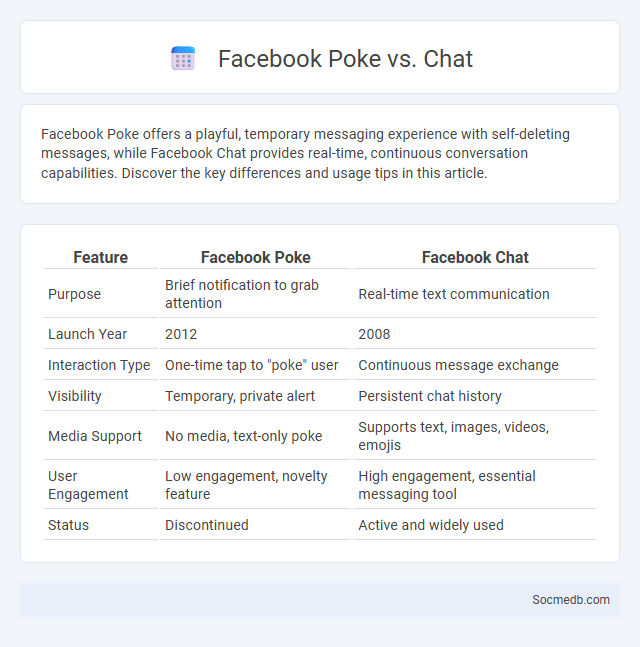
Photo illustration: Facebook Poke vs Chat
Facebook Poke offers a playful, temporary messaging experience with self-deleting messages, while Facebook Chat provides real-time, continuous conversation capabilities. Discover the key differences and usage tips in this article.
Table of Comparison
| Feature | Facebook Poke | Facebook Chat |
|---|---|---|
| Purpose | Brief notification to grab attention | Real-time text communication |
| Launch Year | 2012 | 2008 |
| Interaction Type | One-time tap to "poke" user | Continuous message exchange |
| Visibility | Temporary, private alert | Persistent chat history |
| Media Support | No media, text-only poke | Supports text, images, videos, emojis |
| User Engagement | Low engagement, novelty feature | High engagement, essential messaging tool |
| Status | Discontinued | Active and widely used |
Understanding Facebook Poke: Features and Purpose
Facebook Poke is a feature designed to grab a friend's attention quickly by sending a simple, casual notification without any message. It allows You to interact playfully, serving as a digital nudge or a way to start a conversation on the platform. This tool emphasizes lighthearted social engagement, distinguishing it from more direct communication methods like messaging or commenting.
The Evolution of Facebook Chat
Facebook Chat has evolved from a simple messaging feature launched in 2008 to a comprehensive communication platform integrated with Messenger, enabling instant text, voice, and video interactions. The transition to Facebook Messenger in 2011 introduced real-time messaging, multimedia sharing, and chatbot integration, enhancing user engagement and connectivity. Your ability to connect seamlessly with friends, groups, and businesses through these advanced chat features reflects the ongoing innovation in social media communication technologies.
Poke vs. Chat: Core Differences
Poke and Chat serve different functions on social media platforms, with Poke acting as a quick, non-intrusive way to grab someone's attention without starting a conversation, while Chat provides real-time messaging for more detailed, interactive communication. Your choice between Poke and Chat depends on the level of engagement you want to initiate, with Poke being ideal for casual interactions and Chat better suited for meaningful exchanges. Understanding these core differences helps you leverage social media tools effectively to enhance your online connections.
User Engagement: Poke vs. Chat Interactions
User engagement on social media platforms varies notably between poke and chat interactions, with chat fostering deeper, real-time conversations that enhance connection and retention rates. Poke interactions serve as lightweight, low-commitment signals that can stimulate curiosity and prompt further interaction without requiring immediate response. Metrics indicate chat features increase session duration by up to 40%, while poke interactions contribute to higher initial user re-engagement rates, highlighting their complementary roles in overall platform activity.
Privacy Considerations: Poke and Chat
Social media platforms like Poke and Chat raise critical privacy considerations due to their real-time interaction features and user data collection practices. Users must be aware of data sharing policies, encryption standards, and potential exposure to unauthorized access or data breaches. Implementing robust privacy settings and regularly reviewing app permissions are essential steps to safeguard personal information on these networks.
Popularity Trends: Poke vs. Chat Over the Years
Social media popularity trends reveal a significant shift between Poke and Chat platforms over the years, with Chat apps like WhatsApp and Messenger dominating user engagement due to their instant messaging capabilities and multimedia sharing features. Poke-based platforms lost momentum as users increasingly preferred real-time communication and interactive group chats, driving growth in Chat app downloads and active users. Data from recent studies highlights Chat apps' rise, with over 2 billion monthly active users, contrasting with Poke apps' decline in user retention and activity.
Communication Style: Playful Pokes vs. Instant Chats
Playful pokes on social media create a lighthearted and engaging communication style that fosters casual interactions and sparks curiosity. Instant chats offer real-time, direct exchanges that enhance immediate connections and promote dynamic conversations. Your choice between these methods can shape how relationships develop and maintain engagement online.
Poke Comeback: Why Facebook Revived It
Facebook revived Poke Comeback to capitalize on nostalgia and enhance user engagement with fleeting, playful interactions reminiscent of early social media days. The feature's simple, instant notifications encourage frequent, casual connections that boost time spent on the platform. By reintroducing this interaction, Facebook aims to refresh your social experience and foster organic communication without algorithmic complexity.
User Preferences: Messaging or Poking?
User preferences on social media often revolve around direct messaging or interactive features like poking, reflecting different communication styles. Messaging allows for private, personalized conversations, while poking serves as a playful nudge to grab attention without a full message. Understanding your preferred interaction method helps tailor your social media experience for better engagement and connection.
The Future of Facebook Social Features
Facebook is continuously evolving its social features to enhance user engagement and connectivity through AI-driven content curation and immersive virtual reality experiences. Your interactions will become more personalized with advanced algorithms that prioritize meaningful connections and real-time, interactive group activities. Expect seamless integration of augmented reality tools that transform how you share moments and communicate within your social networks.
 socmedb.com
socmedb.com